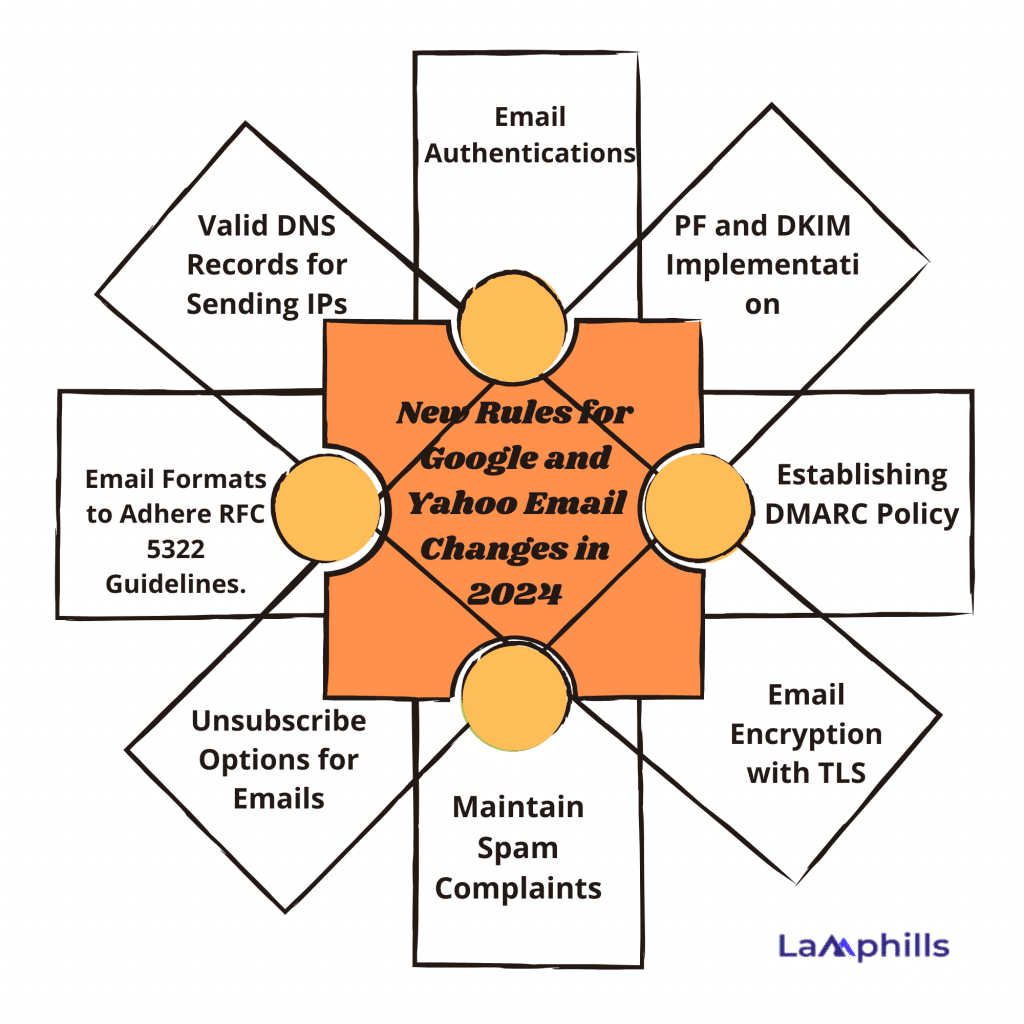You may be thinking 2024 brought a wave of challenges for you as an email marketer or business personnel, especially the new Google and Yahoo email changes with policies that aim to turn the tide. Well, that should not bother you, because I’m here to break it down for you, sharing with you what the policy changes are and how pertinent it is, drawing on both my personal experience and industry expertise. Google and Yahoo’s new email changes is implemented to enhance security and reduce spam. Both require senders to authenticate emails using SPF, DKIM, and DMARC. Given the potential impact on the success of your future email marketing campaigns, it’s crucial to be fully informed about these changes and to understand the steps needed to win in your business in 2024.
Take your time to read through this article, so you could benefit from the tips I’ve listed for you to avoid your account being flagged down and for easy accessibility on your email.
Key Takeaways
- Google and Yahoo have introduced stricter email authentication requirements to enhance security and reduce spam. This change aims to protect users from phishing attempts and other malicious activities that can harm brand reputation and user trust.
- Both email providers emphasize the importance of email encryption and compliance with spam regulations. Google and Yahoo require the use of Transport Layer Security (TLS) to encrypt emails during transmission, ensuring the content remains secure from unauthorized access.
- Ensuring compliance with technical standards and maintaining valid DNS records is essential for email deliverability. Emails must adhere to the Internet Message Format standard (RFC 5322), which includes proper MIME types, header fields, and formatting.
For those of you who are scared, this is some good news. Although the changes were effected from February 1st, 2024, not everyone is expected to be affected at the same time, and those who send large volumes of emails will face enforcement in stages. The start date for non-bulk senders is unknown at this time, so make plans ahead of time so you don’t have to scramble to adjust your strategies the moment the changes are revealed.
New Rules for Google and Yahoo Email Changes in 2024

If you want to maintain the highest standards for your email marketing. Make sure you meet all of these requirements. Before I share the updates with you, let me share the breakdown of enforcement phases:
- February 2024: Major penalties won’t come into effect immediately, instead, bulk email senders will see errors on a small percentage of emails that don’t adhere to the rules.
- April 2024: Google will actively start rejecting a predetermined number of emails that don’t comply with their new requirements. The percentage of rejected emails is set to be increased over time.
- June 2024: Bulk senders need to implement a one-click unsubscribe option.
Listed below are the main focus of the Google and Yahoo email changes:
#1. Email Authentications
Google and Yahoo’s first email change centres on the domain architecture. It requires emails to be verified as legitimate by using DKIM, SPF, and DMARC.
In other words, it aids in the prevention of spam, phishing attempts, and other dangerous behaviours that might harm the reputation of your brand or the receivers’ trust in your emails.
Therefore, it makes sense that Gmail and Yahoo made it mandatory for senders to adhere to email authentication best practices, even though it may appear difficult at first. They do, after all, want their consumers to feel protected and safe.
#2. SPF and DKIM Implementation

Implement Sender Policy Framework (SPF) and DomainKeys Identified Mail (DKIM) for your domain. These protocols authenticate your emails, helping to prevent email spoofing and ensuring recipient servers trust your emails. The reason why this is important is because it proves that the domain your ‘from’ address is yours and that a sender has permission to send the email on your behalf.
#3. Establishing DMARC policy

Establish a Domain-based Message Authentication, Reporting, and Conformance (DMARC) policy. This email validation system helps detect and prevent email spoofing. To pass DMARC, messages must go through DKIM and/or SPF authentication. DMARC instructs the receiving email server on what to do if an email fails SPF or DKIM but appears to be from your domain—indicating possible spoofing.
Once the updates are implemented, both Google and Yahoo will require DKIM, SPF, and DMARC in place, especially for bulk email senders.
Click to Download Lamphill Free Checklist here
#4. Email Encryption with TLS

Use Transport Layer Security (TLS) to encrypt emails during transmission. This ensures that the content of your emails remains secure and unreadable by unauthorized parties, protecting sensitive information.
#5. Maintain Spam Complaints
Ensure that your email practices comply with the CAN-SPAM Act, which mandates criteria for commercial communications, affords recipients the right to opt out of receiving emails, and stipulates severe consequences for non-compliance.
Google and Yahoo email changes bring in different levels of safety as it crack down on spam using complex algorithms. Keep spam complaint rates below 0.3%. High spam rates can affect your sender’s reputation and email deliverability. Ideally, you should keep your average spam level at 0.1% or lower to make sure that your emails are getting to your members’ inboxes. Regularly review feedback from email analytics to identify and address issues that may lead to spam complaints.
The following are some actions you should take if you want to lower the number of spam complaints you receive:
- Provide a simple unsubscribe process (this should be handled by the new header policy).
- Tell recipients to unsubscribe so that the email is not flagged as spam.
- Keep an eye on undeliverable emails and strike the senders from your mailing list.
- Members who request to be removed from mailing lists should receive a prompt response.
- To ensure that you are not “spamming” recipients, consider what you are sending and how frequently.
#6. Unsubscribe Options for Emails

Provide a clear and easy-to-find unsubscribe link in emails. This acknowledges the recipient’s choice, conforms with anti-spam rules, and can enhance the general quality of your mailing list. Senders must now provide a one-click unsubscribe feature and respond to unsubscribe requests within two days, according to these mailbox providers.
If you’re using your mailing system, you must adhere to Google’s instructions to install the one-click unsubscribe feature. However, if you’re using your mailing infrastructure, different email service provider, or have emails sent out from different platforms at the same time – you’ll want to ensure that these tools are all in sync.
Once you’ve completed the process, your subscribers will notice the unsubscribe link next to the “From” address at the top of your emails.
#7. Email Formats to Adhere RFC 5322 Guidelines.
Make sure that the Internet Message Format standard (RFC 5322) is followed when formatting emails. This covers the use of appropriate MIME types, header fields, and email formatting. Email readability is increased and spam filters can be avoided with proper formatting.
#8. Valid DNS Records for Sending IPs
Verify that the forward (A record) and reverse (PTR record) DNS entries for the sending IPs are legitimate. Email deliverability is enhanced and sending source authentication is aided by this.
Tips to Adhere in Respect of Google and Yahoo Email Changes
- Frequently update email lists: Clean your email lists periodically to remove inactive subscribers. This improves engagement rates and aligns with the new policies focused on reducing spam.
- Personalize your content: Customize your emails to match the interests of your audience. This can decrease unsubscription rates and increase engagement.
- Respect privacy and consent: Before adding new receivers to your email lists, you must always get their express agreement to abide by regulations such as the CAN-SPAM Act and GDPR.
- Regularly test different elements of your email campaigns (such as subject lines, content, and send times), and utilize the results to improve subsequent
Strategies to Maintain Compliance and Enhance Email Deliverability
Below are strategies you can put in place to maintain this new rule and enhance your email deliverability.
- Utilize tools such as Google Postmaster Tools to track the reputation of your domain and keep an eye on your sender’s reputation. Email deliverability can be greatly enhanced by having a positive reputation.
- To prevent delivery problems, keep your email size within the suggested ranges, which are often less than 100 KB.
- Avoid triggering spam filters by avoiding words and phrases that are frequently associated with spam. Make sure your emails have a decent text-to-image ratio as well.
- Examine email authentication logs regularly. Make that your DKIM, DMARC, and SPF records are up to date and correctly configured by regularly reviewing and updating them.
Download Lamphill Free Checklist
Can I Use my Yahoo Account with Google?
Sure, you can! Google and Yahoo have made it easier than ever to integrate their services. This is perfect for those of us who manage multiple email accounts and want to streamline our communication. Google’s Gmail now supports Yahoo Mail integration seamlessly. You can add your Yahoo account to Gmail, allowing you to manage both accounts from one interface. It’s a game-changer for productivity. I love this feature because it saves me the hassle of switching between apps. All my important emails, regardless of the provider, are in one place.
Setting it up is straightforward. In your Gmail settings, there’s an option to add another email account. Just follow the prompts to link your Yahoo Mail. Within minutes, your emails from Yahoo will start showing up in your Gmail inbox. It’s that simple!
Benefits of Using a Yahoo Account with Google
- It centralizes your emails, making it easier to manage your communication.
- it utilizes Gmail’s superior spam filtering and organizational tools, which now also apply to your Yahoo emails.
- Having both emails together, Yahoo’s user-friendly design and Google’s powerful functionalities.
Can I merge my Yahoo and Gmail accounts?
Yes, and no. While you can’t technically merge the two accounts into one, you can create a unified experience by linking them.
To create a unified email experience, you can forward your Yahoo emails to Gmail. This way, all your emails come to a single inbox, and you can respond using either account. You can set up filters and labels in Gmail to differentiate emails coming from Yahoo. This helps in keeping things organized.
The option to send emails using Gmail from any account is another wonderful feature. You can select between sending an email from your Yahoo account or your Gmail account when creating a new email in Gmail. This eliminates the inconvenience of constantly signing in and out and is ideal for maintaining separate personal and work email accounts.
This system has changed my life for the better in the few months that I’ve been using it. No more crucial emails getting lost because they were sent to the incorrect inbox. Because everything is in one place, email management is more effective. In addition, utilizing Gmail’s advanced functionalities on both accounts has simplified my daily tasks.
Conclusion
In 2024, Google and Yahoo will be at the forefront of efforts to improve email efficiency, security, and user friendly. These improvements mark a substantial advancement in the way we use our emails—they are not merely minor adjustments. With features that increase productivity and fortified security, these platforms are redefining the world of digital communication.
It translates to an enhanced, safer, and more efficient emailing experience. These changes are meant to make your digital life easier and more secure, whether you’re combining accounts, using new productivity tools, or just enjoying a cleaner inbox.
However, I would like to know if you have observed these changes in your Yahoo and Google accounts. How have they impacted your email experience?
Related Articles
- 11 Google Alerts Alternatives You Should Try Now (Free & Paid)
- Brand Pitch Email Templates: What Major Companies Use To Land 85% Of Their Clients
- 10 Social Responsibility Examples That Will Restore Your Faith in Humanity
- How I Identify Spammy Sites & Deal With Them (Expert Guide)






